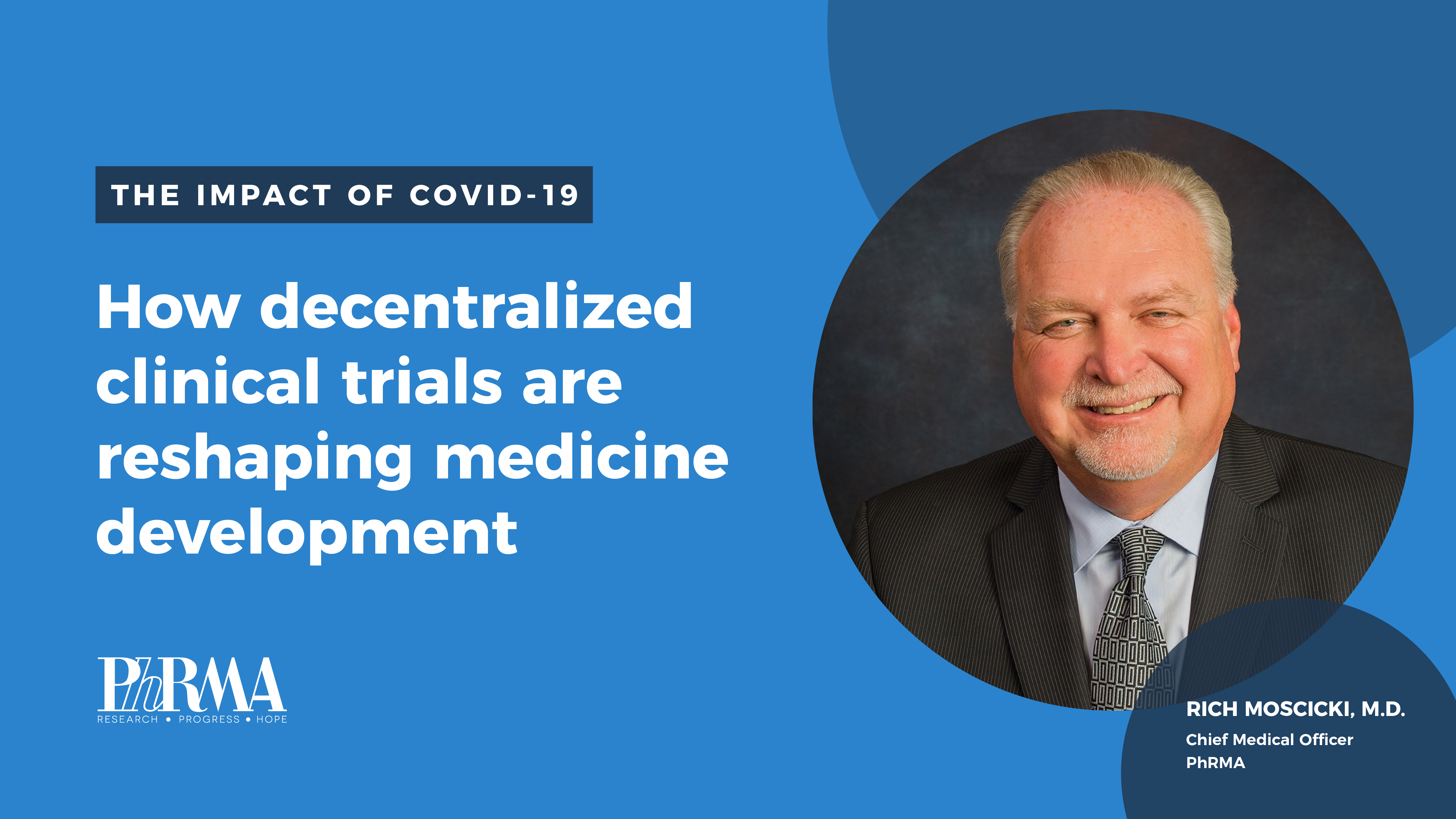 The COVID-19 pandemic has affected nearly every aspect of society, including the way scientists conduct the testing of medicines.
The COVID-19 pandemic has affected nearly every aspect of society, including the way scientists conduct the testing of medicines.
Early on in the pandemic, social distancing measures forced a rapid and widespread adoption of digital technologies to support safer communication between patients and providers. Researchers from Health Affairs studying data have found “during the pandemic, 30.1% of all visits were provided via telemedicine” and that weekly visits occurring for telemedicine rose exponentially from pre-COVID-19 levels.
The broader use of digital technologies during COVID-19 has had an enormous impact on the conduct of clinical trials as well, which typically rely on regular engagement between participants and clinical researchers at a physical trial site. With public health measures limiting the number of in-person visits, trial protocols and procedures have had to adapt, and biopharmaceutical companies have optimized the use of telemedicine, digital health tools and other electronic systems to perform some or all clinical trial-related procedures at locations remote from the study site.
During the pandemic, most clinical trials used a “hybrid” approach using both remote and in-person consultations where possible. These approaches helped to ensure that many clinical trials could continue, and researchers could continue to monitor patient safety and collect as much data about the efficacy of the study medicine as possible.
Incorporating lessons learned from COVID-19 to drug and vaccine development.
Biopharmaceutical companies launched hundreds of clinical trials in the midst of the pandemic to identify treatments and vaccines to help combat and prevent COVID-19, and the number of trials continues to grow. To help navigate clinical trial barriers during COVID-19, the U.S. Food and Drug Administration (FDA) published multiple guidance documents for industry, investigators and institutional review boards regarding the conduct of clinical trials during the pandemic, which were revised as new information became available. Biopharmaceutical companies gathered in unprecedented ways with patients, regulators, health care professionals and each other to share lessons learned regarding the conduct of clinical trials during the pandemic.
Collectively, these efforts helped lay the foundation for potential long-term changes to the clinical trial process that could lead to a more streamlined approach to developing new medicines by:
- Bringing the clinical trial process to patients: Traditional barriers to participating in a clinical trial stem from the fact that in most cases, patients must travel to a physical hospital or clinic, which can be burdensome due to, for example, the frequency of visits or distance to the trial site. In contrast, decentralized clinical trials allow patients to be enrolled and monitored remotely which reduces the burden on patients to participate in studies. Prior to the pandemic, some researchers already employed these types of trials, but challenges stemming from the global shutdown quickly spurred further adoption. Broader acceptance of telemedicine and digital health tools during the pandemic made conduct of decentralized clinical trials possible.[i]
For example, subject to applicable laws and regulations, some study medicines can be shipped to patients directly. In lieu of a patient traveling to a trial site for data collection, patients can report their experience remotely and digital tools such as wearables can be used to collect data. In some cases, qualified providers can travel to a patient’s home to administer a study drug or conduct an at-home study visit.
Once a clinical study is separated from a specific site, such as a large hospital in an urban setting, the opportunity to participate can be widely extended to patients who otherwise could not access certain physical enrollment locations or may have found participation inconvenient. This may allow further participation by populations that have traditionally been underrepresented in studies, such as people from certain racial and ethnic groups.
- Increasing the use of real-world data (RWD) and real-world evidence (RWE): Recent advances in information technology and data science have enhanced our ability to generate timely insights on the use, benefits and risks of medicines, including RWD. RWD can help fill critical evidence gaps, leading to more efficient drug development programs and providing additional types of information about the benefits and risks of new medicines.
RWE, the evidence about the usage and potential benefits or risks of a drug or biologic that is generated by analyzing RWD, can assess a broader range of outcomes in a wider range of patients, providing additional valuable information reflective of patients’ perspectives and experiences. These new forms of information can ultimately lead to more timely access to innovative, safe and effective medicines for patients.
Biopharmaceutical companies are eager to work with the FDA to continue building on ongoing activities and lessons learned during COVID-19 to increase the use of RWE in regulatory decision-making. This could include greater use of external data sources outside of clinical trials (e.g., RWD, e-source, registry, natural history, etc.), remote patient monitoring and data capture, and utilizing RWE to help identify shifts in treatment paradigms. Incorporating these lessons learned during the pandemic presents an opportunity for the FDA and industry to align on regulatory approaches that best benefit public health. Industry continues to use RWD in novel ways which will help promote a foundation for a more consistent and predictable approach in evaluation of RWE.
Looking to the future.
It is important to continue to catalogue which innovations were deployed or expanded during the global pandemic and the operational, medical, technological and quality/regulatory considerations that pose unique challenges to biopharmaceutical companies. Additionally, it will be important to evaluate the impact of these innovations on the patients to ensure patient-centric clinical trials moving forward and to identify if they were successful in correctly demonstrating safety and efficacy. Biopharmaceutical companies continue to work with stakeholders, including regulators, to assess to what extent these innovative approaches and durable learnings should be utilized routinely in medical product development in the future.
As biopharmaceutical research companies continue to pursue new medicines and vaccines, the regulatory environment is adapting to better support decentralized studies. Meanwhile, as patients and investigators become more comfortable with digital technologies, these types of trials are likely to become more widely used, with positive implications lasting long beyond our fight with COVID-19.
[i] (i.e., remote, patient-centric, site-less, or direct-to-patient)



 The COVID-19 pandemic has affected nearly every aspect of society, including the way scientists conduct the testing of medicines.
The COVID-19 pandemic has affected nearly every aspect of society, including the way scientists conduct the testing of medicines.